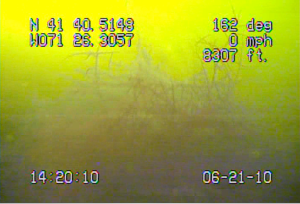On June 21, in collaboration with the University of Rhode Island’s Cell & Molecular Biology department, we completed a videotaping survey throughout six different locations in Narragansett Bay. We will be surveying six locations throughout Greenwich Bay. Click on the map below to see our locations marked in yellow.
[googlemaps http://maps.google.com/maps/ms?ie=UTF8&hl=en&msa=0&msid=103382247568443412834.00048af7f4a77de62dac3&t=h&ll=41.671466,-71.435667&spn=0.02943,0.021252&output=embed&w=425&h=350]
 |
| Liquid Nitrogen Storage Tank. |
 |
| Sediment samples |
A GPS, in correlation with the program Chartview Pro, was used to track the exact locations that we surveyed so we can return to them each time. At each of the six locations, we used the SeaViewer Underwater camera to capture video clips of the benthic regions in the Bay. We used a YSI to measure temperature, salinity, dissolved oxygen (DO), and chlorophyll at surface and bottom depths (click on yellow icons above to see our readings). A Niskin water sampler was used to take water samples at the bottom, as well as a sediment grab which plunges into the ground to collect sediment samples. The sediment samples were preserved in a liquid nitrogen storage tank. Both sediment and water samples will be tested by the molecular biology students.
 |
Aghardiella (a red branching seaweed) with
Ulva (green "sea lettuce) underneath. |
After viewing the video footage, we found a plethora of interesting marine life living in the sediment in the Bay. For instance, single-celled algae was found, as well as the red algae
Aghardiella species and
Gracilaria species
. Ctenophores, commonly referred to as “comb jellies” were also abundant at the surface and benthic regions in the Bay. Amphipods, tunicates, and crabs were among the other species found within the sediment.
 |
| Aghardiella (a red branching seaweed) |








No comments:
Post a Comment